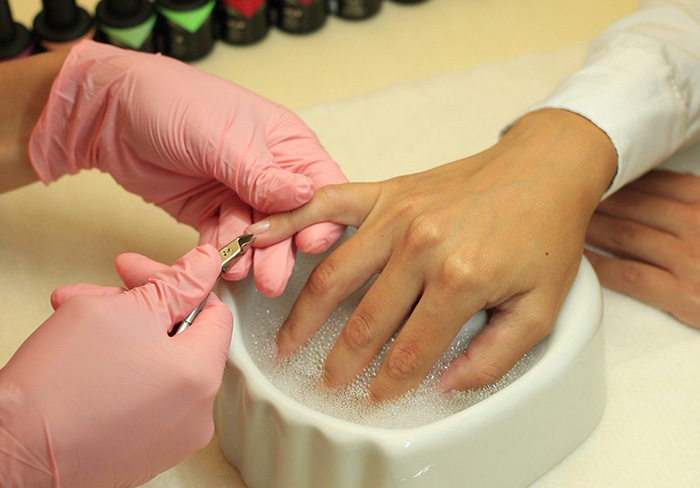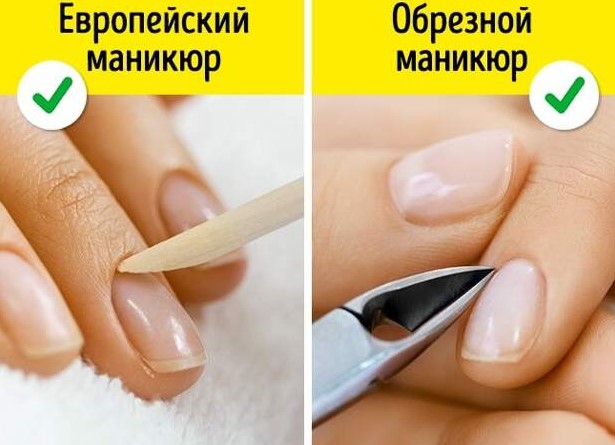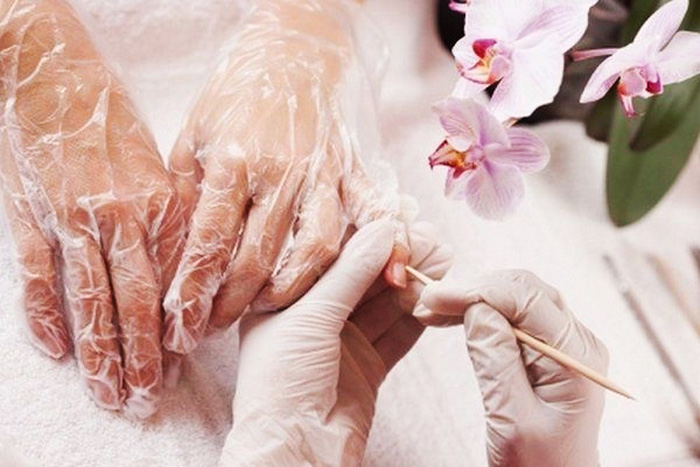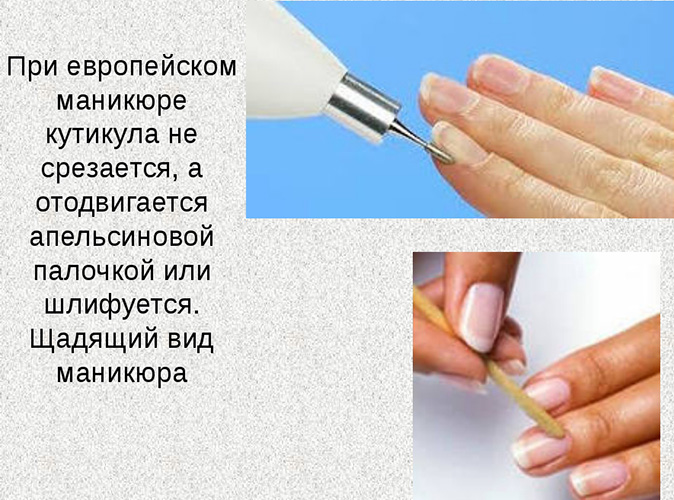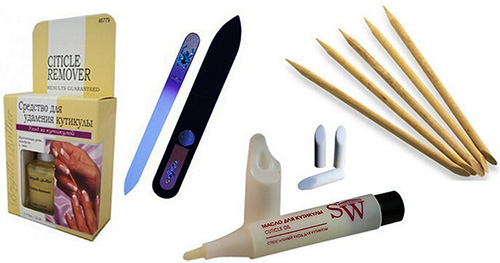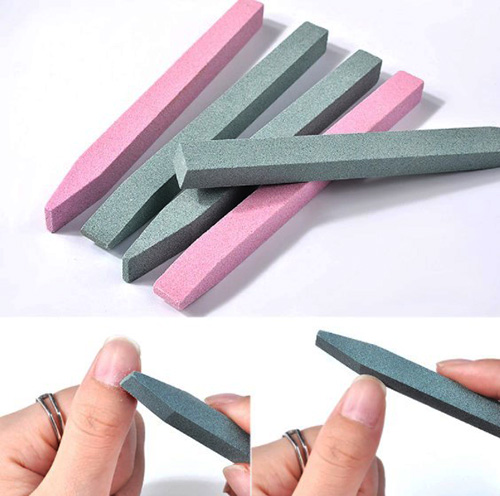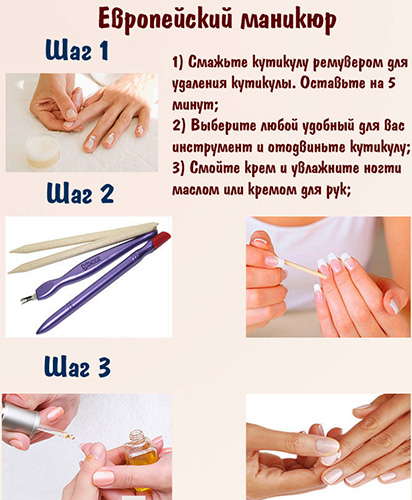European manicure is unique nail plate care technique without the use of piercing and cutting tools, designed to ensure the aesthetic beauty of the hands, to deliver to a woman or a man extremely painless and only pleasant sensations. The popularity of the unique "unedged" technique is explained by modern technical innovations that make it possible to conduct such sessions both in beauty salons and at home.
Features of European manicure
The history of nail care manipulations in the development of civilization is considered one of the oldest, dating back millennia. Archaeologists have found sets for processing nail plates during excavations in the ruins of Babylon. The found instruments were made about 3,000 years ago.
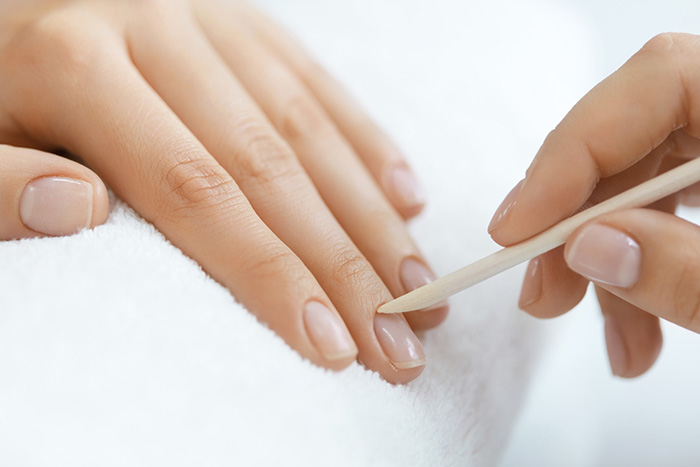
The study of the found artifacts made it possible to make an amazing discovery - it turns out that the manicure business not only existed in Ancient Egypt, but also flourished quite successfully. It is no coincidence that quite professional recipes for beauty, including for fingernails, were described in the famous book of Queen Cleopatra.
In the Celestial Empire, long and well-groomed nail plates had a slightly different meaning - they testified to the wisdom of their owner. In ancient Russia, nail care, especially a haircut, was shrouded in secret and superstitious signs, was more emotional than aesthetic.
The art of manicure in its modern representation was formed around the middle of the 19th century. and since then has been constantly improving, following fashion trends and technological innovations. Traditionally, hand care techniques have consisted of taking a bath to soak the nail plates, followed by their processing using scissors and other cutting tools.
Historians associate the development of the unedged method of nail care with the reign of the French king Louis Philippe, for whom, as the legend says, the technique that has become popular among the aristocratic strata of society was developed.
The name "European manicure" means a gentle and safe way of carrying out the procedure. The essence of the cosmetic ritual lies in the features of the preparation and processing of the cuticle, on which a special remover liquid is applied. The product contains acids and other substances that help soften and dissolve this area of the skin.
The only thing left for the master is to protect the body of the nail - with a special orange stick or a pusher / scraper to move and remove the cuticle. The side rollers also remain intact, only slightly pushed back with the same tool.
In this case, both causing any harm to the skin or the nail plate, and the appearance of blood or painful wounds are excluded. A session of competently performed manipulations does not cause any unpleasant sensations, the effective effect after several receptions lasts for many months.
Advantages and disadvantages
European manicure is a fundamentally new method of hand care, the main advantage of which is the fact that the skin around the nail plate is not cut off, but gently pushed back, after which a traditional set of necessary measures is taken.
The advantages of the proposed technology lie in the following factors:
- The unedged procedure is especially suitable for people with fragile, brittle and thin nails, as well as delicate skin that requires delicate cuticle handling due to closely spaced capillaries.
- The presented option, used at home, is distinguished by a significant economy both in the funds spent for the upcoming session on the purchase of the necessary materials, and in terms of the time spent - the standard procedure will take a total of no more than 20-30 minutes.
- An important plus is the emotional factor. Such a gentle technique does not cause panic fear even before the metal tweezers begin their "edging" work. In the process of carrying out a European manicure, there are no pain or other unpleasant sensations, accompanied by a feeling of discomfort.
- Of particular importance is the bloodlessness and hygiene of the procedure, there is no risk of infectious infections.
- The cuticle in the process of arranged events is not subjected to mechanical stress, the work of the master is aimed at freeing the nail bed. Such manipulation strengthens the nail root, promotes its growth, and provides free oxygen access.
- The possibility of replacing cutting tools with cosmetics that can effectively soften the structure of the skin allows it to be processed without sharp tweezers (tweezers), after which further cuticle growth is significantly slowed down, so manicure can be done much less frequently.
- The use of removers, which contain vitamins, fruit and lactic acids, vegetable oils and extracts, has a positive effect on the condition of the nail plates and skin, improves the quality of the epidermis, removes dead tissue without harming the living.
However, the presented technique has certain disadvantages and objective disadvantages.
When choosing this technique, you need to take into account such significant circumstances:
- European manicure is not suitable for people with problematic cuticles - deformed, dry, altered, rapidly growing and dense;
- this technique is not suitable for extended nails;
- the process of transition from the classical technique using scissors and other cutting tools to unedged procedures is associated with the need for more frequent renewal of the coating carried out;
- to make the epidermis as soft and pliable as possible, it is necessary to regularly arrange the necessary manipulations - to systematically push back the cuticle, treat it with specially selected moisturizing and nourishing compositions containing plant components;
- in some cases, the means used to soften the cuticle can cause an allergic reaction;
- the result of the procedures performed can be observed only after 5-6 times.
The first session of the proposed unedged technique is recommended to take place in a salon, where such services will be provided by a professional employee with a technique perfected to perfection and experience.
Types of European manicure
A salon specialist will help you choose the right technique, who will objectively assess the features of the skin, the condition of the nail plates, taking into account the personal preferences of the client. The master will not only perform all the necessary manipulations, but also give useful tips and recommendations for self-processing nails at home.
European manicure is an opportunity for an individual approach to the maintenance of hands in a proper condition for a well-groomed lady.
The table shows the most popular types of developed techniques, their brief characteristics:
| Technician names | Features of cosmetic activities |
| Wet (hot) manicure | The presented technique (maceration), reminiscent of a kind of relaxation, is considered elite, suitable for brittle nails, and is also used in the presence of a weak, heavily overgrown, sometimes injured cuticle to the formation of painful microcracks. To minimize these complications, hot baths are used, the temperature of which reaches 50 ° C. Fingers are immersed in a container of heated lotion, oil (such as olive), cream, or moisturizing essence. Weakened nails, including plates after building or unsuccessful removal of gel polish, are best kept in broths of linden, sage, nettle or mint. Exposure to high temperatures contributes to the concentration of microelements useful for the skin and nails, which leads to a quick and powerful result. After the effect is obtained, the master proceeds to basic manipulations. It is recommended to arrange a similar procedure once a month. |
| Brazilian spa manicure | This is a fairly new type of nail service. The presented technique has a technique similar to the previous technique, but instead of hot baths, gloves are used, in which the nails seem to be immersed in moisturizing compositions enriched with mineral components. This stage of the session lasts about 10-15 minutes, then the gloves are removed one by one, the nails are processed in the usual order for European manicure. All the necessary accessories for home use of this technique are included in the disposable kits. |
| Dry manicure | This method is not associated with "bath" procedures for the purpose of softening (steaming) the cuticle, therefore it is recommended for the treatment of strong and healthy nails without mechanical damage. A feature of the technique is the absence of any special devices for its execution, the ability to carry out manicure both at home and in any other place, for example, while traveling. It's just that the cuticle is treated with a remover (dissolving gel to remove dead tissue), after which it remains to move the side rollers, perform cleansing manipulations, lubricate the plates with a hardener. |
| Combined technique | This type of manicure is intended for cases when it is not possible to do only with European technology, since there is a need to eliminate some drawback, for example, burrs, using forceps or other metal tools. With this technique, "dry" and "wet" techniques can be combined, which is determined on an individual basis. |
| Hardware manicure | This is a type of salon unedged manicure, which is performed using a special device designed for grinding nails using rotating nozzles. This technique is considered one of the varieties of the "dry" technique. |
European manicure requires a careful study of the developed technology, because the choice of the appropriate option is an important decision for every woman. General information about the types of techniques presented will allow you to get answers to the main questions in order to prepare for the manipulations at home.
Which manicure is better: edged or unedged
The answer to this question lies in the physiological plane - the unedged technique is suitable for owners of delicate, thin skin without rough, rapidly growing cuticle areas, which can only be removed in a classical way using scissors and forceps.
Each of the techniques - traditional or European - has both advantages and certain disadvantages. When choosing one of the techniques, the health and beauty of nails is of paramount importance, so on this issue it is worth seeking a comprehensive consultation from a professional cosmetologist.
What you need for a manicure
European manicure is, first of all, equipping a home procedure with special accessories and required means.
The kit for the upcoming session should include the following set of instruments and related formulations:
- Hand towel. This attribute will bring maximum benefit if it is made of cotton natural fabric, has excellent hygroscopicity (ability to give and absorb moisture) fibers. For these purposes, disposable paper napkins are also suitable, which, although consumed in increased quantities, are recognized as being as hygienic as possible.
- Water tank. The container should be chosen in such a way that a hand can fit freely in it.
- Cotton pads / swabs and nail polish removers. The choice of the necessary liquid formulations (with or without ammonia) depends on the specific type of coating - with regular or gel polish.
- Orange sticks. This item, made of the tree of the same name, has antiseptic properties and is intended for single use. Each stick is made sharp on one side, designed to clean the space under the nail plates, and beveled on the other - to remove the cuticle after it has softened.
- A pusher will perform similar goals instead of orange sticks (a manicure spatula made in the form of a hatchet or spear) or a scraper. Which tool to give preference to - you need to decide on an individual basis. High-quality pushers, consisting of medical steel, do not slip in the hand during operation, however, they require careful handling, since sharp blades can damage the nail plate. Plastic varieties of such devices are considered short-lived, therefore they are not popular with manicurists. At home, at first, it is still safer to use wooden objects.
- File or polishing buff... This accessory, most often made in the form of a polyhedron, is covered with a special natural or artificial material with a high degree of abrasiveness (hardness). Such a tool is designed to prepare the nail for applying varnish - grinding and smoothing the existing irregularities of the plate. Frequent use of the file should not be abused; it is quite enough to use it 1-2 times a month.
- Cuticle oil. You can buy a similar composition at the pharmacy, giving preference to such saturated substances as, for example, peach, a product from the tea tree, shea, and other components. The tool is used at the final stage to remove the cuticle. When choosing removers or keratolics, it is recommended to pay attention to the components that contain: vitamin E, lactic and fruit acids.
- Base. The substance is represented by a thick rubber mass, which serves to level the plate before its direct staining with gel polish, improve the adhesive (“sticking”) abilities to the nail, and acts as a prevention of chips.
- Primer. The role of this component lies in the translation of the term from English and means the word "primer". The tool performs almost the same function as the base, but has fundamental differences - the substance does not create an independent layer, is intended for degreasing and drying the nail plate, acts as a kind of adhesive tape, providing a "coupling" of the artificial material and the nail. An updated option for a slightly soft-touch nail polish with a translucent satin effect is a matte or glossy top.
- Pumice. It is a versatile tool made from natural material in unedged technique. It is advisable to choose a product with rounded ends and small cells.
European manicure is a well-groomed hands with delicate and velvety skin, perfectly processed nails. At the final stage, you should definitely use a high-quality hand cream.
Such a standard product, which is necessary to smooth the sensation of dry skin, performs another important function - it acts as an epidermal (lipid) barrier, effectively solving many skin problems.
Features of European manicure files
When performing the unedged technique, a specialized tool has certain differences from the usual objects used to correct the length and shape of the nail plates.
The principle of operation of the file, designed specifically for European manicure, remains the same, but the design features of the object have specific features due to the purpose of using the accessory - the application on soft, non-keratinized areas of the skin occurs with the most gentle and safe effect.
The material of the file made of glass, crystal or diamond-coated is particularly elastic and flexible, the structure of the object repeats the configuration of a honeycomb.
During manipulation on pre-steamed fingers, the instrument remains dry, which allows you to effortlessly work with a file in any direction without risk of injury to the skin / cuticle or cause even minimal harm.
Home technology
The technology of the presented unedged technique is not complicated, however to obtain the maximum effect, it is necessary to clearly perform the following step-by-step actions:
- First, you need to thoroughly wash your hands, treat them with antiseptic agents. The tools are supposed to be disinfected.
- If a pumice stone is used during the procedure, it should be slightly moistened, which will make the stone softer, not traumatizing the tissues adjacent to the nail plate.
- Initially, it is necessary to correct the shape and length of the nails, using a special file for this, holding it at an angle of 90 ° during work. The best option would be a glass tool that will not damage the skin, crack or split nails. The file should be directed in one direction. So that the plates do not subsequently exfoliate, the manicure masters recommend giving the nails a square or oval shape.
- After that, you can start steaming the skin of the hands with the use of fragrances and emollient compositions. It will not be superfluous to pre-treat your fingers with a scrub to soften the skin, at the same time remove small burrs.
- If there are no special products at hand, you can make a solution of 3 liters of purified water, 10-12 drops of base oil, 5-6 slices of lemon, 2 tbsp. l. sea salt.
- At the next stage, you need to blot your fingers with a towel or disposable paper napkins, then you need to apply a special agent (remover) of softening properties to the cuticle and surrounding tissue. Its duration is indicated by the manufacturer on the packaging jar.
- After that, with the help of an orange stick, gently, without strong pressure on the plate, move the cuticle to the base of the nail root.
- Now it is necessary to process the vacated bed with a pumice stone. This should be done with gentle movements, directing the stone in one direction, as if erasing some inscription with an eraser. If a cream is used for such purposes, it should be applied to the skin and nails in a circular manner.
- After the performed manipulations, it is required to remove the remnants of the cosmetic product with a napkin, apply a softening cream to the hands with massage movements.
- If you have to cover your nails with colored varnish, you need to degrease the plates with a primer, before applying paint, use a previously purchased base, as well as a top coat.
European manicure is a universal technique, therefore the presented procedure is fully suitable for both the fairer sex and the strong half of humanity.
Video about European manicure
Master class on European manicure:

